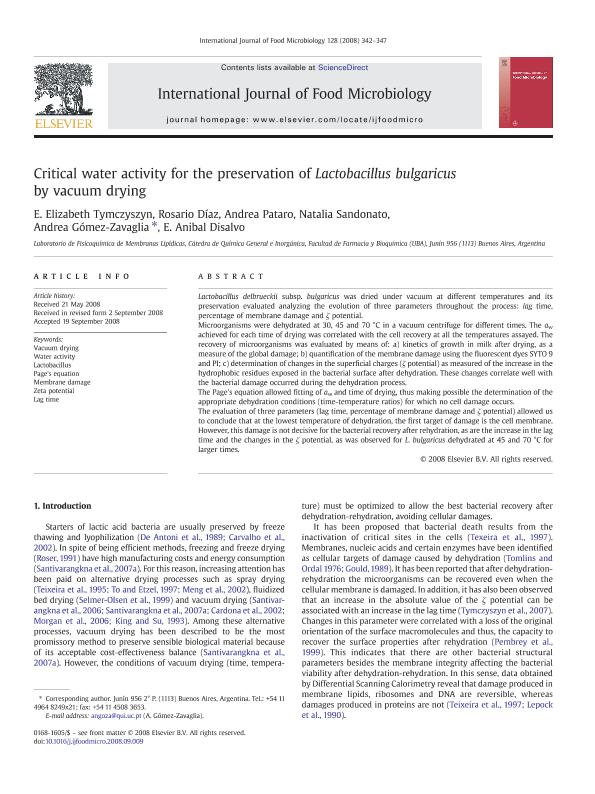Mostrar el registro sencillo del ítem
dc.contributor.author
Tymczyszyn, Emma Elizabeth

dc.contributor.author
Díaz, Rosario
dc.contributor.author
Pataro, Andrea
dc.contributor.author
Sandonato, Selva Sonia

dc.contributor.author
Gomez Zavaglia, Andrea

dc.contributor.author
Disalvo, Edgardo Anibal

dc.date.available
2022-05-13T17:27:23Z
dc.date.issued
2008-12
dc.identifier.citation
Tymczyszyn, Emma Elizabeth; Díaz, Rosario; Pataro, Andrea; Sandonato, Selva Sonia; Gomez Zavaglia, Andrea; et al.; Critical Water Activity for the Preservation of Lactobacillus bulgaricus by Vacuum Drying; Elsevier Science; International Journal of Food Microbiology; 128; 12-2008; 342-347
dc.identifier.issn
0168-1605
dc.identifier.uri
http://hdl.handle.net/11336/157502
dc.description.abstract
Lactobacillus delbrueckkii subsp. bulgaricus was dried under vacuum at different temperatures and its preservation evaluated following three parameters: lag time, percentage of membrane damage and z potential). Microorganisms were dehydrated at 30, 45 and 70 ºC in a vacuum centrifuge for different times. The water activity (aw) achieved at each time of drying for the temperatures of dehydration were correlated with the cell recovery evaluated by means of: a) kinetics of growth in milk after drying, as measure of the global damage; b) quantification of the membrane damage using the fluorescent dyes SYTO 9 and PI.; c) determination of changes in the superficial charges (z potential) as measured of the increase in the hydrophobic residues exposed in the bacterial surface after dehydration. The dyes are able to penetrate healthy bacterial cells. The difference is that SYTO 9 generally labels all bacteria in a population (those with intact and those with damaged membranes) whereas, PI penetrates only when bacterial membranes are damaged, causing a reduction in the SYTO 9 fluorescence when both dyes are present. These changes correlate well with the bacterial damage occurred during the dehydration process. The standardization of the vacuum drying process was done by applying the Page´s model by the determination of parameters k (drying rate constant) and n (drying time index) for different conditions. The fitting of the plot aw vs time of drying allows the determination of dehydration parameters in appropriate time-temperature ratios in which no cell damage occurs. The evaluation of three parameters of damage (lag time, percentage of membrane damage and z potential) allowed us to conclude that at the lowest temperature of dehydration, cell membrane damage is not crucial for the bacterial recovery after rehydration. The slow leak out of non-bound water occurs and the first target of damage is the as are the increase in the lag time and the changes in the zeta potential, as was observed for microorganisms dehydrated at 45 and 70 ºC for larger times.
dc.format
application/pdf
dc.language.iso
eng
dc.publisher
Elsevier Science

dc.rights
info:eu-repo/semantics/openAccess
dc.rights.uri
https://creativecommons.org/licenses/by-nc-sa/2.5/ar/
dc.subject
Vacuum drying
dc.subject
Water activity
dc.subject
Lactobacillus
dc.subject
Page's equation
dc.subject
Membrane damage
dc.subject.classification
Alimentos y Bebidas

dc.subject.classification
Otras Ingenierías y Tecnologías

dc.subject.classification
INGENIERÍAS Y TECNOLOGÍAS

dc.title
Critical Water Activity for the Preservation of Lactobacillus bulgaricus by Vacuum Drying
dc.type
info:eu-repo/semantics/article
dc.type
info:ar-repo/semantics/artículo
dc.type
info:eu-repo/semantics/publishedVersion
dc.date.updated
2022-05-12T16:31:33Z
dc.journal.volume
128
dc.journal.pagination
342-347
dc.journal.pais
Estados Unidos

dc.description.fil
Fil: Tymczyszyn, Emma Elizabeth. Consejo Nacional de Investigaciones Científicas y Técnicas; Argentina. Universidad de Buenos Aires. Facultad de Farmacia y Bioquímica. Departamento de Química Analítica y Fisicoquímica. Cátedra de Química General e Inorgánica; Argentina
dc.description.fil
Fil: Díaz, Rosario. Universidad de Buenos Aires. Facultad de Farmacia y Bioquímica. Departamento de Química Analítica y Fisicoquímica. Cátedra de Química General e Inorgánica; Argentina
dc.description.fil
Fil: Pataro, Andrea. Universidad de Buenos Aires. Facultad de Farmacia y Bioquímica. Departamento de Química Analítica y Fisicoquímica. Cátedra de Química General e Inorgánica; Argentina
dc.description.fil
Fil: Sandonato, Selva Sonia. Universidad de Buenos Aires. Facultad de Farmacia y Bioquímica. Departamento de Química Analítica y Fisicoquímica. Cátedra de Química General e Inorgánica; Argentina
dc.description.fil
Fil: Gomez Zavaglia, Andrea. Universidad de Buenos Aires. Facultad de Farmacia y Bioquímica. Departamento de Química Analítica y Fisicoquímica. Cátedra de Química General e Inorgánica; Argentina. Consejo Nacional de Investigaciones Científicas y Técnicas. Oficina de Coordinación Administrativa Houssay; Argentina
dc.description.fil
Fil: Disalvo, Edgardo Anibal. Universidad de Buenos Aires. Facultad de Farmacia y Bioquímica. Departamento de Química Analítica y Fisicoquímica. Cátedra de Química General e Inorgánica; Argentina. Consejo Nacional de Investigaciones Científicas y Técnicas. Oficina de Coordinación Administrativa Houssay; Argentina
dc.journal.title
International Journal of Food Microbiology

dc.relation.alternativeid
info:eu-repo/semantics/altIdentifier/url/https://www.sciencedirect.com/science/article/abs/pii/S0168160508005199
dc.relation.alternativeid
info:eu-repo/semantics/altIdentifier/doi/http://dx.doi.org/10.1016/j.ijfoodmicro.2008.09.009
Archivos asociados
